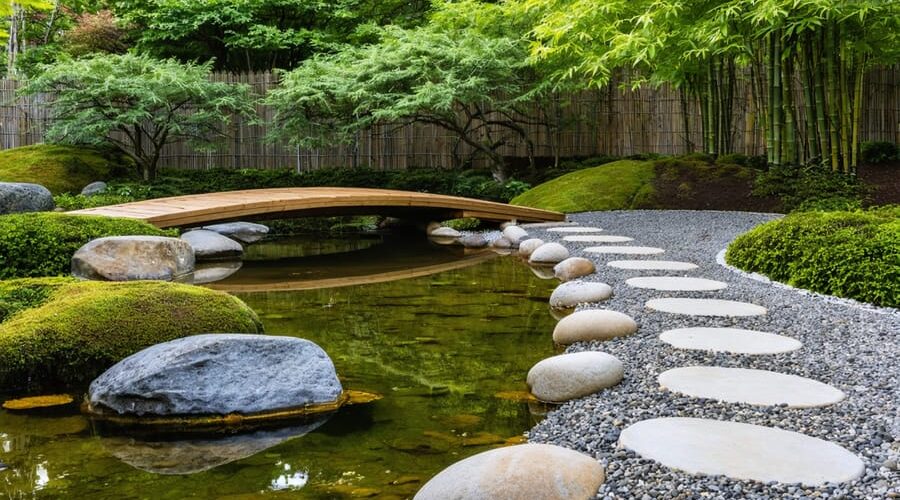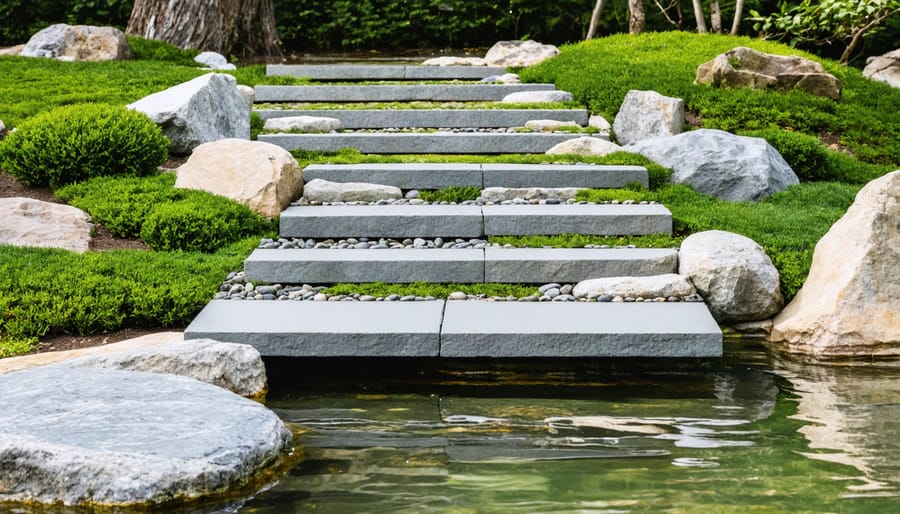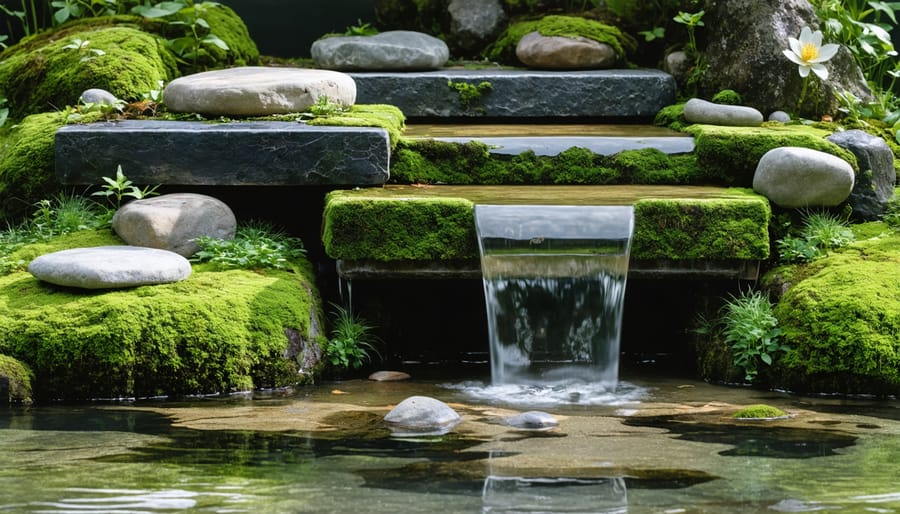
These Traditional Japanese Materials Create Stunning, Eco-Friendly Water Gardens
Choose river stones and weathered granite for authentic Japanese aesthetics that naturally filter water and prevent erosion for decades without degrading. These materials develop character over time through mineral deposits and moss growth, eliminating the need for replacement while maintaining your water garden’s ecological balance.
Source bamboo fencing and edging from renewable harvests rather than pressure-treated lumber, creating natural barriers that decompose without releasing toxins into your pond ecosystem. Bamboo’s three-to-five-year growth cycle makes it one of the most sustainable hardscape options available, and its hollow structure provides beneficial insect habitats.
Select reclaimed cedar or redwood for bridges and benches, as these rot-resistant woods last 20-plus years without chemical treatments that harm aquatic life. Look for FSC-certified options at salvage yards where you’ll find aged lumber with rich patina that immediately creates the weathered look Japanese gardens are known for.
Layer decomposed granite and pea gravel around water features instead of concrete, allowing rainwater to permeate naturally while preventing muddy runoff. This permeable approach reduces maintenance time and supports the beneficial bacteria colonies that keep your pond water crystal clear.
Plant native ground covers like moss and low-growing sedges between stepping stones to soften hardscape edges while requiring zero irrigation once established. These living materials connect your sustainable choices into a cohesive design that feels both ancient and purposeful.
Why Japanese Garden Materials Are Naturally Sustainable
Japanese gardens have been getting sustainability right for centuries, long before it became a modern buzzword! The traditional philosophy behind these peaceful spaces centers on a simple but powerful idea: work with nature, not against it. When I first started studying Japanese garden design, I was amazed to discover that what we call eco-friendly practices today were simply common sense to Japanese gardeners hundreds of years ago.
At the heart of Japanese garden design is the concept of respect for natural materials. Rather than importing exotic stones or heavily processed products, traditional practitioners selected locally available resources that already existed in harmony with their environment. This meant fewer transportation miles, less energy consumption, and materials perfectly suited to local climate conditions. These sustainable material choices weren’t just practical; they created gardens that felt authentically connected to their surroundings.
What really sets Japanese garden materials apart is their longevity. Think about natural stone, bamboo, and aged wood. These materials improve with time rather than deteriorate. That weathered patina on a stone lantern or the silvery gray of weathered cedar isn’t damage – it’s character! This philosophy means you’re creating features that can last generations with minimal maintenance.
The minimal processing approach is another sustainability winner. Japanese gardeners traditionally used materials in their most natural state possible. Rough-hewn stones, unfinished wood, and naturally shaped bamboo require far less energy to produce than their polished, manufactured counterparts. You’re essentially letting nature do the heavy lifting, which saves resources and creates a more authentic aesthetic. This gentle approach to materials creates gardens that breathe with the seasons and age gracefully, becoming more beautiful as years pass.

Natural Stone: The Foundation of Japanese Water Features
Granite and Basalt
When I first started building my pond, I grabbed whatever rocks looked pretty at the garden center. Big mistake! I learned that granite and basalt are the rock stars of Japanese water gardens, and for good reason. These volcanic stones are incredibly durable and can withstand decades of water exposure without breaking down or leaching unwanted minerals into your pond.
What makes these stones truly special is how they age. Unlike some materials that look worse over time, granite and basalt develop a beautiful patina as moss and algae gently colonize their surfaces. This weathered appearance is exactly what traditional Japanese garden design celebrates – that perfect blend of permanence and natural change.
Here’s a tip that’ll save you money and help the planet: check out local quarries before ordering stones from across the country. I found a granite supplier just 30 miles from my home, which meant lower costs and a much smaller carbon footprint than importing stone from distant locations. Plus, using locally-sourced stone helps your garden feel more connected to your regional landscape.
When selecting pieces, look for stones with interesting textures and varied colors – the natural variations create visual interest around pond edges and make each placement unique.
River Rock and Pebbles
River rocks and pebbles are the unsung heroes of Japanese water gardens, creating those beautiful, natural-looking transitions between water and land. I learned this the hard way when I first lined my pond with sharp-edged gravel and wondered why it looked so harsh! The smooth, rounded stones you see in traditional designs aren’t just pretty—they serve real purposes in drainage and erosion control around pond edges.
When selecting river rocks, you’ll want a mix of sizes, from small pebbles around 1-2 inches to larger river stones up to 6 inches. This variety mimics what you’d find along a natural stream bed. Look for stones in earth tones like gray, brown, and tan that complement your water feature.
Here’s the sustainability angle: instead of importing expensive stones from Japan, source locally whenever possible. Visit nearby quarries, landscaping suppliers, or even riverbeds (with proper permits) to find beautiful native rocks. Many regions have stunning local stone that works perfectly in Japanese-style designs. If you live near water sources, you might discover gorgeous rounded stones right in your area.
For eco-conscious gardeners, consider reclaimed stones from demolition sites or other landscaping projects. These salvaged materials reduce environmental impact while adding character to your garden. Just make sure they’re thoroughly cleaned before adding them to your pond ecosystem.
Placement Tips for Water Garden Edges
Creating beautiful water garden edges with Japanese stones is easier than you might think! Start by selecting flat or gently rounded stones that complement your pond’s size—larger ponds can handle bolder rocks, while smaller features look best with more delicate stones.
Begin by placing your largest anchor stones at key viewing points around the pond’s perimeter. These foundation pieces set the tone for your entire design. I learned this the hard way when I started with small stones first and ended up rearranging everything twice! Position them slightly overlapping the water’s edge to create a natural transition between land and water.
Next, fill in between your anchor stones with medium-sized rocks, varying their placement to avoid rigid patterns. Leave some gaps for emergent plants—this adds softness and helps with natural filtration. For erosion control, angle stones slightly inward toward the water, which directs runoff while protecting the pond liner from UV damage.
The bottom layer should include smaller stones and pebbles that nestle into gaps, preventing soil washout during heavy rains. This creates a stable foundation while allowing beneficial bacteria to colonize the surfaces, boosting your pond’s biological filtration.
Remember: nature isn’t symmetrical! Step back frequently during placement to view your work from different angles, adjusting until the arrangement feels effortlessly balanced.
Bamboo: Versatile and Fast-Growing
Bamboo Fencing and Screens
Bamboo fencing transforms your water garden into a peaceful sanctuary by creating natural privacy screens and windbreaks. I’ve found it works beautifully around ponds to block sightlines from neighbors while maintaining that authentic Japanese garden feel. The gentle rustling of bamboo in the breeze adds wonderful ambient sound near your water features.
When choosing bamboo, you’ll encounter two main options. Treated bamboo undergoes pressure treatment or coating to resist moisture and insects, lasting 10-15 years with minimal maintenance. Natural bamboo offers a more authentic appearance and better sustainability but typically lasts 3-7 years depending on your climate. I recommend natural bamboo for areas with good drainage and treated options for spots directly exposed to pond splash or constant moisture.
For installation, consider rolled bamboo fencing secured to existing posts for budget-friendly privacy, or invest in traditional bamboo panel screens that stand independently. Position screens to create intimate viewing spots around your pond or to hide utility areas like filters and pumps. The vertical lines of bamboo naturally draw the eye upward, making small spaces feel more expansive while complementing the horizontal plane of your water surface. Remember to leave small gaps between panels for airflow, preventing moisture buildup that shortens bamboo’s lifespan.

Water Spouts and Deer Scarers (Shishi-Odoshi)
Nothing captures the zen essence of a Japanese garden quite like the gentle tock-tock-splash of a shishi-odoshi deer scarer. These charming bamboo water features were originally designed to startle deer away from crops, but today they create meditative soothing sounds that transform any garden space.
The magic happens when water slowly fills a hollow bamboo tube mounted on a pivot point. Once full, the tube tips forward, empties with that satisfying splash, then rocks back to strike a stone with a resonant knock. I remember installing my first one and being amazed at how something so simple could be so captivating.
To create your own, you’ll need a thick bamboo culm cut just above a natural node, a support frame, and a steady water source from your pond pump or fountain. Position the bamboo so it tilts naturally when empty, with the open end pointing upward at about 45 degrees. Cut a small notch on the underside for water to flow in smoothly. The striking stone should be positioned where the back end contacts it.
Pair your deer scarer with subtle water feature lighting for evening ambiance. The rhythmic pattern creates a peaceful meditation tool that connects you with nature’s simple pleasures.
Maintaining Bamboo in Wet Environments
Bamboo near water needs extra love to stay beautiful and functional! I learned this the hard way when my first bamboo water spout turned fuzzy with mold after just one season. The key is creating a protective barrier before moisture becomes a problem.
Start by applying a natural tung oil or exterior-grade wood sealer to all bamboo pieces before installation. Pay special attention to cut ends where water sneaks in easily. Reapply sealant every spring, or twice yearly if your bamboo gets constant water exposure. This simple step can double your bamboo’s lifespan from 2-3 years to 5-6 years.
Watch for telltale signs it’s replacement time: soft spots when you press the surface, visible cracks longer than an inch, or that musty smell that won’t go away. Split bamboo pieces degrade faster than whole poles, so check those decorative edging pieces more frequently.
Here’s my favorite trick: keep a spare bamboo piece or two stored in your garage. When one section starts looking tired, you can swap it out immediately rather than watching your whole feature deteriorate. Think of bamboo as a renewable element in your garden, not a permanent fixture, and you’ll enjoy its beauty without frustration.
Reclaimed and Weathered Wood
Cedar and Cypress for Longevity
When I built my first Japanese-style bridge over my pond, I quickly learned why cedar and cypress have been favorites in Japanese gardens for centuries. These woods contain natural oils that make them incredibly resistant to rot, moisture, and insect damage—perfect qualities when you’re working around water!
Cedar, particularly Western Red Cedar, contains thujaplicins—natural preservatives that protect the wood from decay. You’ll notice its lovely reddish tone that gradually weathers to a silvery gray, adding character over time. Cypress, especially Japanese Hinoki cypress, has similar protective oils and boasts exceptional strength despite being lightweight. Both woods can last 15-20 years or more in wet conditions without any chemical treatments.
I’ve used cedar for my pond bridge decking and stepping stone paths, and it’s held up beautifully through rain, snow, and humidity. The wood feels warm underfoot and develops a gorgeous patina that actually enhances the natural aesthetic. For DIY projects, these woods are forgiving to work with—they cut cleanly, resist splitting, and don’t require special tools.
While cypress tends to be pricier, both options are sustainable choices when sourced from responsibly managed forests. Look for FSC-certified suppliers, and you’ll have materials that honor both Japanese tradition and environmental stewardship. Your water garden structures will thank you for decades to come!
The Beauty of Wabi-Sabi: Embracing Aged Materials
Here’s something I’ve learned from years of watching my own water garden evolve: the magic happens when you stop fighting nature and start embracing it. This is the heart of wabi-sabi, a beautiful Japanese philosophy that finds perfection in imperfection and celebrates the natural aging process.
Instead of replacing that weathered wooden bridge the moment it shows signs of wear, consider how those silvery-gray tones tell a story. That moss creeping across your stone lantern? It’s not a problem to fix, it’s character developing before your eyes. Japanese garden design has honored this concept for centuries, understanding that a crack in a stone or the patina on aged bamboo adds depth and authenticity that brand-new materials simply can’t match.
I encourage you to seek out salvaged wood for your pond edging or garden structures. Old fence posts, reclaimed timber from demolished buildings, or weathered barn wood all carry history and unique texture. These materials not only reduce waste but also bring instant maturity to your space. Let your bamboo fencing fade from bright green to warm golden-brown. Allow copper accents to develop their signature verdigris. Watch as natural stone slowly acquires lichen patterns.
This approach isn’t just philosophically satisfying; it’s incredibly practical and sustainable, saving you money while creating a garden that grows more beautiful with time.
Gravel and Sand: Simple Ground Covers with Purpose
Decomposed Granite for Pathways
Decomposed granite, or DG as many gardeners call it, is one of my favorite materials for creating permeable pathways around water features. This natural, crushed stone material comes in lovely earth tones that complement Japanese garden aesthetics beautifully while allowing rainwater to soak through instead of running off.
The installation is wonderfully straightforward. Start by excavating your path about 3-4 inches deep, then lay landscape fabric to prevent weeds. Add your DG and compact it lightly with a hand tamper or by misting with water. The material will naturally bind together, creating a firm yet slightly crunchy surface that’s perfect for strolling around your pond.
Maintenance is minimal, which I absolutely love. You’ll occasionally need to top-dress the path and pull any persistent weeds, but that’s about it. One tip from my own garden: edge your DG paths with larger stones or timber to keep the material contained and looking sharp. This creates beautiful definition while preventing the granite from migrating into your pond.
Creating Dry Stream Beds
Creating a dry stream bed, or karesansui, is one of my favorite Japanese garden features because it brings the calming essence of water without the maintenance! Here’s how to achieve this beautiful effect in your garden.
Start by mapping out your stream’s path with a garden hose, creating gentle curves that mimic natural water flow. Remember, water never flows in straight lines! Excavate the bed about 4-6 inches deep, making it wider at bends where water would naturally slow down.
Line the area with landscape fabric to prevent weeds, then layer your materials thoughtfully. Use larger river rocks along the edges as banks, then fill the center with pea gravel or crushed granite in shades of gray, white, or tan. The Japanese principle of ma, or negative space, is crucial here – less is more!
Create the illusion of movement by raking patterns into sand or fine gravel. Swirls around larger stones suggest eddies, while parallel lines indicate flowing currents. For practical overflow management during heavy rains, position your dry stream bed along natural drainage paths, allowing it to serve double duty as both art and function.

Living Materials: Moss and Ground Covers
Encouraging Moss Growth
Moss is nature’s way of giving your Japanese garden that timeless, weathered character you’re after. The good news? Encouraging it is surprisingly simple! Start by selecting shady, damp areas around your pond or water features where moss naturally thrives. You can jumpstart growth by blending existing moss with buttermilk or plain yogurt to create a slurry, then painting it onto stones and surfaces where you want coverage.
Keep these areas consistently moist during the establishment period – a gentle misting each day works wonders. Within weeks, you’ll notice that beautiful green carpet forming. Beyond aesthetics, moss provides incredible ecosystem benefits for your water garden. It helps retain moisture in the soil, reduces erosion around pond edges, and creates microhabitats for beneficial insects. As moss spreads across your stones and wooden elements, it delivers that authentic aged appearance that makes Japanese gardens feel so peaceful and established. Remember, patience is key – moss grows slowly but rewards you with low-maintenance, evergreen beauty.
Low-Growing Plants for Patio Crevices
Skip the concrete and let nature do the work! Low-growing plants like Irish moss, creeping thyme, and baby tears make wonderful living grout between stepping stones and patio pavers. These tiny champions soften the harsh lines of hardscaping while staying tough enough to handle light foot traffic.
I’ve planted creeping Jenny between my water garden’s border stones, and it’s been a game-changer. The plants create a lush, carpet-like effect that looks deliberately placed, not weedy. Even better, they attract beneficial pollinators and provide habitat for helpful insects that keep garden pests in check.
Start by leaving wider gaps than you would for traditional grout, about 1-2 inches between stones. Fill with a sandy soil mix, tuck in small plant divisions, water regularly for the first month, and watch them spread naturally. They’ll root into crevices you didn’t even know existed, creating that aged, lived-in look Japanese gardens are famous for while requiring zero synthetic materials.
Sourcing Sustainable Japanese-Inspired Materials Locally
You don’t need to ship materials halfway around the world to create an authentic Japanese-inspired garden. I learned this lesson after pricing imported granite and nearly falling off my chair! The secret is knowing where to look locally and understanding which characteristics really matter.
Start with your local stone yard. Most carry granite, basalt, or limestone that works beautifully for Japanese aesthetics. Look for stones with interesting weathering patterns, natural moss patches, or subtle color variations. The owner at my neighborhood yard helped me find gorgeous lichen-covered boulders that had been sitting in their back lot for years. Don’t be shy about asking to explore beyond the display area.
Reclamation centers are absolute treasure troves. Old bridge timbers make stunning water basin supports, while reclaimed slate works perfectly for stepping stones. I once found century-old granite curbing that became the anchor piece for my pond edge. These materials already have that weathered, timeless quality that new products lack, plus you’re giving them new life.
Visit native plant nurseries instead of hunting for Japanese species. Many North American plants offer similar aesthetics with better local adaptation. Native ferns, hostas, and ornamental grasses thrive without intensive care and support local ecosystems.
When might imports make sense? Specialized items like authentic granite lanterns or specific bamboo varieties sometimes justify the carbon footprint, especially if they’re heirloom pieces you’ll treasure for decades. But honestly, the most sustainable Japanese garden reflects your local landscape rather than fighting against it.
Creating your own Japanese-inspired water garden doesn’t have to happen overnight, and that’s actually part of its beauty. Start with just one or two materials that speak to you – maybe a weathered stone beside your pond or a simple bamboo water feature. As you watch how these elements interact with your space and the changing seasons, you’ll naturally discover what comes next.
The wonderful thing about choosing sustainable materials is that you’re not sacrificing anything in terms of beauty. In fact, natural stones that develop moss, locally-sourced wood that weathers gracefully, and living plants that evolve through the seasons often create more authentic and captivating gardens than brand-new materials ever could. These choices honor both the Japanese design principles we’ve explored and our responsibility to the environment.
I’ve learned through my own water gardening journey that patience is just as important as any material you’ll select. Each stone you place, each plant you introduce, becomes part of an unfolding story. Your garden will teach you what it needs, and you’ll find joy in those small additions and adjustments along the way.
So take that first step today. Choose one element that excites you and begin crafting your peaceful oasis. Your future self will thank you for creating a space where beauty, sustainability, and tranquility flow together naturally.
